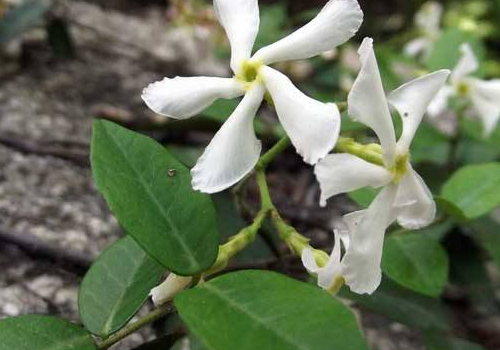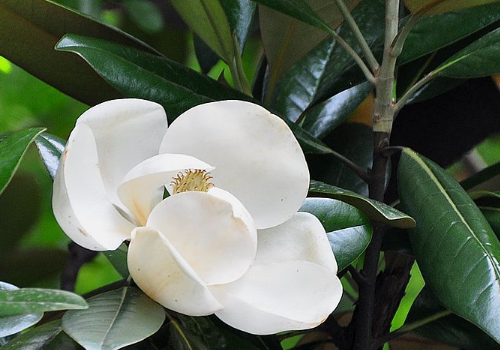The solution of how to raise common insect pests in Maojasmine
Hairy jasmine is a kind of flower that is very similar to jasmine. How to raise it? Solutions to common pests:
How to raise Mao jasmine:
1. Planting: potted hairy jasmine, every 2-3 years, should turn the pot in March or after flowering. The basin soil can be prepared with 2 parts of garden soil, 1 part of compost and 1 part of sand.
2. Fertilization: 20% cake fertilizer and water was applied once a week, and phosphorus and potassium were applied twice in summer to promote shoot enrichment and flower bud differentiation.
3. Watering: watering to keep the basin soil moist. When the air is dry, it should be humidified by spraying water around noon. In early November, move into the greenhouse 4, sunny place or sealed balcony, watering as appropriate, do not make the soil too dry.
During the growing season, adequate light should be given at all times except for shade around noon in midsummer.

Solutions to common pests of hairy jasmine:
The main results are as follows: 1. The method of controlling the leaf roll moth: first, cut off the damaged parts and prevent and cure the infection of other branches and leaves, then spray the medicine 25% triazole tin wettable powder 1000-2000 times, and finally catch the insects manually to get rid of the insects thoroughly.
2. Methods for the prevention and control of red spiders: first of all, 20% dicofol is sprayed with 1000-1500 times of dicofol, followed by spraying with some soap liquid, tobacco liquid, washing powder solution, etc., which can also be used to control red spiders. Finally, using bugs hostile to red spiders, such as ladybugs and lacewings, put them together with red spiders, wait for them to be removed, and then release them.
You've learned how to raise jasmine.
Little tricks to help your flowers and plants solve insect pests
Chrysanthemum
Many people like to raise some flowers and plants indoors, which not only greens the environment but also edifies interest. But flowers and plants are not only a little delicate, but also easily "favored" by some bugs, which is annoying and helpless. Next, we will introduce several common pests of flowers and plants and their control methods.
Chrysanthemums attract aphids easily
Aphids, mostly green and black, are good at flying, tube-shaped and flea-like. It likes chrysanthemums, bauhinia, roses, roses and other flowers. Often cluster in the tender tips of flowers, flowers and leaf back, absorb juice, make leaves wrinkle, affect flowering. Generally speaking, insect pests begin to be more obvious in the middle of April.
Countermeasures: when sporadic aphids appear, brush them off with a brush dipped in water, and the aphids under the brush should be dealt with in time to prevent spread. You can also add 1 kg of water to 40 grams of tobacco, filter the original solution after soaking for 48 hours, dilute it with 1 kg of water, add 2 grams of washing powder or a little soap, stir well and spray the plant. Using physical methods, you can use cardboard or plastic board coated with yellow and glue to trap and kill aphids, or use silver tin foil to reflect light to drive away aphids.
Jasmine beware of red spiders
Red spider is Obovate, the back and abdomen are flat, there are red, dark red, orange red and so on. Orchids, jasmine and kumquat are easy to recruit red spiders. It is often hidden on the back of the leaves and buds of flowers, causing the leaves to lose green and wither, the buds to wither, and in severe cases, the plants will wither and die. In general, insect pests are more serious from June to July.
Countermeasures: soak the orange peel with 10 times water for one day and night, filter and spray the plant once every day for 3 consecutive days. In addition, a plate of mosquito-repellent incense can be lit and placed in a flowerpot, and then tied tightly with a plastic bag. After 1 hour of smoking, both eggs and adults can be killed. This is a good way to save money and get quick results.
The rose is far away from the yellow snail moth.
The head of the larva is yellowish brown, the chest is yellowish green, and there is a pair of thorns on each side of the dorsal line. More common in camellias, bauhinia, rose, West House Begonia, and so on, often eat up the leaves of flowers.
Countermeasures: yellow thorn moth likes light, has a strong phototaxis, and can be trapped and killed by a lamp next to the flower.
In addition, brown and pointed insects of plants such as anthurium and cyclamen are often "attacked", as well as mosquito-like mosquitoes and flies that love to grow in poinsettias and pansy, which can be sprayed with garlic juice, pepper water and pepper water at the initial stage.
(the writer is a professor at Nanping Agricultural School in Fujian Province)
Little tricks to help your flowers and plants solve insect pests
Chrysanthemum
China Garden Network, November 4 news: many people like to raise some flowers and plants indoors, which not only greens the environment but also edifies interest. But flowers and plants are not only a little delicate, but also easily "favored" by some bugs, which is annoying and helpless. Next, we will introduce several common pests of flowers and plants and their control methods.
Chrysanthemums attract aphids easily
Aphids, mostly green and black, are good at flying, tube-shaped and flea-like. It likes chrysanthemums, bauhinia, roses, roses and other flowers. Often cluster in the tender tips of flowers, flowers and leaf back, absorb juice, make leaves wrinkle, affect flowering. Generally speaking, insect pests begin to be more obvious in the middle of April.
Countermeasures: when sporadic aphids appear, brush them off with a brush dipped in water, and the aphids under the brush should be dealt with in time to prevent spread. You can also add 1 kg of water to 40 grams of tobacco, filter the original solution after soaking for 48 hours, dilute it with 1 kg of water, add 2 grams of washing powder or a little soap, stir well and spray the plant. Using physical methods, you can use cardboard or plastic board coated with yellow and glue to trap and kill aphids, or use silver tin foil to reflect light to drive away aphids.
Jasmine beware of red spiders
Red spider is Obovate, the back and abdomen are flat, there are red, dark red, orange red and so on. Orchids, jasmine and kumquat are easy to recruit red spiders. It is often hidden on the back of the leaves and buds of flowers, causing the leaves to lose green and wither, the buds to wither, and in severe cases, the plants will wither and die. In general, insect pests are more serious from June to July.
Countermeasures: soak the orange peel with 10 times water for one day and night, filter and spray the plant once every day for 3 consecutive days. In addition, a plate of mosquito-repellent incense can be lit and placed in a flowerpot, and then tied tightly with a plastic bag. After 1 hour of smoking, both eggs and adults can be killed. This is a good way to save money and get quick results.
The rose is far away from the yellow snail moth.
The head of the larva is yellowish brown, the chest is yellowish green, and there is a pair of thorns on each side of the dorsal line. More common in camellias, bauhinia, rose, West House Begonia, and so on, often eat up the leaves of flowers.
Countermeasures: yellow thorn moth likes light, has a strong phototaxis, and can be trapped and killed by a lamp next to the flower.
In addition, brown and pointed insects of plants such as anthurium and cyclamen are often "attacked", as well as mosquito-like mosquitoes and flies that love to grow in poinsettias and pansy, which can be sprayed with garlic juice, pepper water and pepper water at the initial stage.
(the writer is a professor at Nanping Agricultural School in Fujian Province)
- Prev

How to fertilize the leaves of Luoshihua?
It has a very high ornamental value, so it is deeply loved by the majority of consumers. How to fertilize Luoshihua? How to lose leaves: how to fertilize Luoshihua: Luoshihua likes fertilizer, but it is not demanding, all kinds of fertilizers can be used, it can blossom without fertilization for a year, but the amount of flowers is less. Potted stone flowers want to make them bloom like flowers.
- Next

What is the value of how to raise Magnolia in winter?
The efficacy and function of Magnolia magnolia is still very high, not only has ornamental value but also medicinal value. How to raise Magnolia in winter? What is the value: how to raise Magnolia in winter: 1. After transplantation, in order to improve the survival rate and reduce transpiration, we should often replenish water to the tree, according to the different conditions of temperature and humidity.
Related
- Fuxing push coffee new agricultural production and marketing class: lack of small-scale processing plants
- Jujube rice field leisure farm deep ploughing Yilan for five years to create a space for organic food and play
- Nongyu Farm-A trial of organic papaya for brave women with advanced technology
- Four points for attention in the prevention and control of diseases and insect pests of edible fungi
- How to add nutrient solution to Edible Fungi
- Is there any good way to control edible fungus mites?
- Open Inoculation Technology of Edible Fungi
- Is there any clever way to use fertilizer for edible fungus in winter?
- What agents are used to kill the pathogens of edible fungi in the mushroom shed?
- Rapid drying of Edible Fungi

